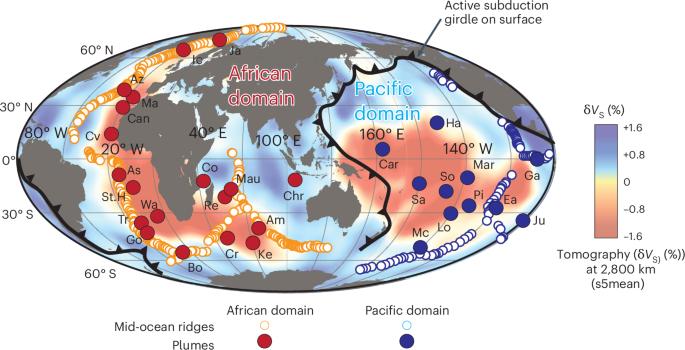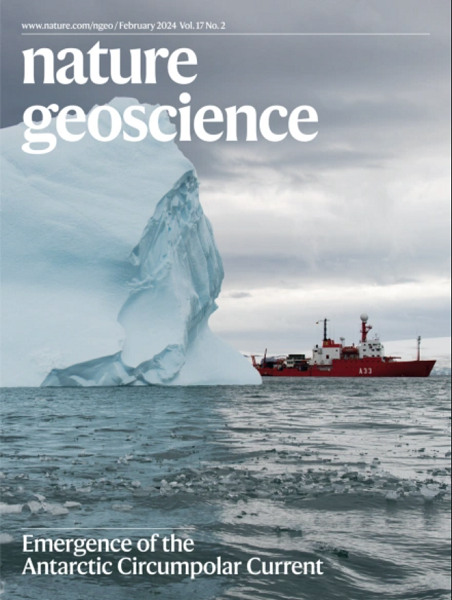Large-scale mantle heterogeneity as a legacy of plate tectonic supercycles
IF 15.7
1区 地球科学
Q1 GEOSCIENCES, MULTIDISCIPLINARY
引用次数: 0
Abstract
The Earth’s mantle is divided by the circum-Pacific subduction girdle into the African and Pacific domains, each featuring a large low-shear-wave-velocity province (LLSVP) in the lower mantle. However, how this hemispherical-scale mantle structure links to Earth’s plate tectonic evolution remains unclear. Previous geochemical work has suggested the presence of a north–south hemispheric subdivision, with large-scale mantle heterogeneities in the Southern Hemisphere, termed the DUPAL (Dupré and Allegre) anomaly. Here we compile elemental and isotopic data of both shallow-mantle-derived oceanic igneous rocks from mid-ocean ridges and deeper-mantle plume-related samples (ocean islands and oceanic plateaus) and analyse these using supervised machine learning classification methods. Data from both shallow- and deeper-mantle-sourced samples illustrate a consistent chemical dichotomy. Our results indicate that heterogeneities in the present-day shallow and deep mantle are not exclusively controlled by the north–south hemispheric DUPAL anomaly. Instead, they are consistent with a chemical dichotomy between the African and Pacific mantle domains and their associated LLSVPs. These observations can best be explained by tectonic supercycles over the past one billion years involving two supercontinents and two superoceans. Samples from both the shallow and deeper mantle suggest a consistent geochemical dichotomy between the African and Pacific mantle domains that is developed through tectonic supercycles, according to a supervised machine learning study.


板块构造超级周期遗留的大规模地幔异质性
地球地幔被环太平洋俯冲带分为非洲域和太平洋域,下地幔各有一个大型低剪切波速度区(LLSVP)。然而,这种半球尺度的地幔结构与地球板块构造演化之间的联系仍不清楚。之前的地球化学研究表明,南半球存在一个南北向的半球分区,其大规模地幔异质性被称为 DUPAL(Dupré 和 Allegre)异常。在这里,我们汇编了来自洋中脊的浅地幔海洋火成岩和深地幔羽状岩相关样本(海洋岛屿和海洋高原)的元素和同位素数据,并使用监督机器学习分类方法对这些数据进行了分析。来自浅海和深海幔源样本的数据显示了一致的化学二分法。我们的研究结果表明,当今浅层和深层地幔的异质性并不完全受南北半球 DUPAL 异常的控制。相反,它们与非洲地幔域和太平洋地幔域之间的化学二分法及其相关的 LLSVPs 是一致的。这些观测结果可以用过去十亿年中涉及两个超级大陆和两个超级大洋的构造超级周期得到最好的解释。
本文章由计算机程序翻译,如有差异,请以英文原文为准。
求助全文
约1分钟内获得全文
求助全文
来源期刊

Nature Geoscience
地学-地球科学综合
CiteScore
26.70
自引率
1.60%
发文量
187
审稿时长
3.3 months
期刊介绍:
Nature Geoscience is a monthly interdisciplinary journal that gathers top-tier research spanning Earth Sciences and related fields.
The journal covers all geoscience disciplines, including fieldwork, modeling, and theoretical studies.
Topics include atmospheric science, biogeochemistry, climate science, geobiology, geochemistry, geoinformatics, remote sensing, geology, geomagnetism, paleomagnetism, geomorphology, geophysics, glaciology, hydrology, limnology, mineralogy, oceanography, paleontology, paleoclimatology, paleoceanography, petrology, planetary science, seismology, space physics, tectonics, and volcanology.
Nature Geoscience upholds its commitment to publishing significant, high-quality Earth Sciences research through fair, rapid, and rigorous peer review, overseen by a team of full-time professional editors.
 求助内容:
求助内容: 应助结果提醒方式:
应助结果提醒方式:


